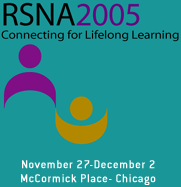
Abstract Archives of the RSNA, 2005
Nabile M. Safdar MD, Presenter: Nothing to Disclose
Jonathan Vinh Mai MD, Abstract Co-Author: Nothing to Disclose
Khan Mohammad Siddiqui MD, Abstract Co-Author: Nothing to Disclose
Rabeea Janjua, Abstract Co-Author: Nothing to Disclose
Eliot Lawrence Siegel MD, Abstract Co-Author: Nothing to Disclose
This study was designed to determine whether there is significant degradation in the visual acuity of radiologists during the course of an average workday in a filmless imaging department.
A growing body of literature suggests that fatigue and eyestrain may play significant roles in visual performance tasks, both in industry and in medical applications. In this study, 3 versions of an intermediate distance (81.3 cm) Snellen visual acuity test were administered to 23 radiologists at 2 large tertiary care hospitals. Visual acuity measurements were obtained from radiologists working at both 5-megapixel CRT and 2-megapixel LCD monitors between 7:50 and10:30 am, 12:00 and 3:30 pm, and after 3:30 pm on several workdays. Participants completed questionnaires regarding age, history of ophthalmologic surgical or medical history, and amount of sleep during the previous night.
The mean decimal visual acuity for all radiologists at all sites was 1.2, which correlates approximately to a Snellen ratio of 25/20. The lowest visual acuity measured for any radiologist was 0.67 (Snellen 20/30), and the highest was 1.6 (Snellen 20/12.5). No significant difference was found in mean visual acuity measured during morning, midday, and late afternoon sessions.
Our results indicated no degradation of visual acuity among radiologists working in filmless departments and that the mean visual acuity of the radiologists measured was, in fact, better than 20/20. However, anecdotal evidence obtained during this same study suggests that acuity is not an adequate assessment metric for radiologist performance, and that such an assessment should also consider eye-tracking, search-and-identify tactics, and sustained vigilance. Additional studies have been implemented to determine whether such metrics provide insight into time-of-day performance in image interpretation.
Safdar, N,
Mai, J,
Siddiqui, K,
Janjua, R,
Siegel, E,
Evaluation of the Visual Acuity of Radiologists. Radiological Society of North America 2005 Scientific Assembly and Annual Meeting, November 27 - December 2, 2005 ,Chicago IL.
http://archive.rsna.org/2005/4419610.html

